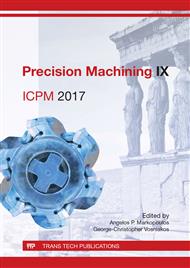[1]
Sreejith, P. and B. Ngoi, Material removal mechanisms in precision machining of new materials. International Journal of Machine Tools and Manufacture, 2001. 41(12): pp.1831-1843.
DOI: 10.1016/s0890-6955(01)00014-1
Google Scholar
[2]
Wu, C., B. Li, and S.Y. Liang, A critical energy model for brittle–ductile transition in grinding considering wheel speed and chip thickness effects. Proceedings of the Institution of Mechanical Engineers, Part B: Journal of Engineering Manufacture, 2016. 230(8): pp.1372-1380.
DOI: 10.1177/0954405416654194
Google Scholar
[3]
Nikumb, S., et al., Precision glass machining, drilling and profile cutting by short pulse lasers. Thin Solid Films, 2005. 477(1): pp.216-221.
DOI: 10.1016/j.tsf.2004.08.136
Google Scholar
[4]
Pan, Z., et al., Analytical model for force prediction in laser-assisted milling of IN718. The International Journal of Advanced Manufacturing Technology, 2016. doi: 10. 1007/s00170-016-9629-6.
Google Scholar
[5]
Young, H., H. -T. Liao, and H. -Y. Huang, Surface integrity of silicon wafers in ultra precision machining. The International Journal of Advanced Manufacturing Technology, 2006. 29(3-4): pp.372-378.
DOI: 10.1007/s00170-005-2508-1
Google Scholar
[6]
Liang, S. and J. -C. Su, Residual stress modeling in orthogonal machining. CIRP Annals-Manufacturing Technology, 2007. 56(1): pp.65-68.
DOI: 10.1016/j.cirp.2007.05.018
Google Scholar
[7]
Shao, Y., B. Li, and S.Y. Liang, Predictive Modeling of Surface Roughness in Grinding of Ceramics. Machining Science and Technology, 2015. 19(2): pp.325-338.
DOI: 10.1080/10910344.2015.1018535
Google Scholar
[8]
Peascoe, R.A. and T.R. Watkins, Effect of cutting-edge geometry and workpiece hardness on surface residual stresses in finish hard turning of AISI 52100 steel. J Manuf Sci Eng, 2000. 122(1): pp.642-649.
DOI: 10.1115/1.1286369
Google Scholar
[9]
Outeiro, J., D. Umbrello, and R. M'saoubi, Experimental and numerical modelling of the residual stresses induced in orthogonal cutting of AISI 316L steel. International Journal of Machine Tools and Manufacture, 2006. 46(14): pp.1786-1794.
DOI: 10.1016/j.ijmachtools.2005.11.013
Google Scholar
[10]
Semiatin, S. and T. Bieler, The effect of alpha platelet thickness on plastic flow during hot working of Ti–6Al–4V with a transformed microstructure. Acta materialia, 2001. 49(17): pp.3565-3573.
DOI: 10.1016/s1359-6454(01)00236-1
Google Scholar
[11]
Field, M. and J. Kahles, The surface integrity of machined-and ground high-strength steels(Surface integrity of machined and ground high strength steels). 1964., 1964: pp.54-77.
Google Scholar
[12]
Griffiths, B., White layer formations at machined surfaces and their relationship to white layer formations at worn surfaces. J. Tribology(Trans. ASME), 1985. 107(2): pp.165-171.
DOI: 10.1115/1.3261015
Google Scholar
[13]
Che-Haron, C. and A. Jawaid, The effect of machining on surface integrity of titanium alloy Ti–6% Al–4% V. Journal of Materials Processing Technology, 2005. 166(2): pp.188-192.
DOI: 10.1016/j.jmatprotec.2004.08.012
Google Scholar
[14]
Popov, K.B., et al., Micromilling: material microstructure effects. Proceedings of the Institution of Mechanical Engineers, Part B: Journal of Engineering Manufacture, 2006. 220(11): pp.1807-1813.
DOI: 10.1243/09544054jem683
Google Scholar
[15]
DeVor, R., S. Kapoor, and D. Bammann, Microstructure-level modeling of ductile iron machining. (2002).
DOI: 10.1115/imece2001/med-23314
Google Scholar
[16]
Zhipeng Pan, A.T., Donald S. Shih, Hamid Garmestani, Steven Y. Liang, The Effects of Dynamic Evolution of Microstructure on Machining Forces. Proceedings of the Institution of Mechanical Engineers, Part B: Journal of Engineering Manufacture, 2017. DOI: 10. 1177/0954405417703430.
DOI: 10.1177/0954405417703430
Google Scholar
[17]
Wan, Z., et al., Microstructure evolution of adiabatic shear bands and mechanisms of saw-tooth chip formation in machining Ti6Al4V. Materials Science and Engineering: A, 2012. 531: pp.155-163.
DOI: 10.1016/j.msea.2011.10.050
Google Scholar
[18]
Fanfoni, M. and M. Tomellini, The johnson-mehl-avrami-kohnogorov model: a brief review. Il Nuovo Cimento D, 1998. 20(7-8): pp.1171-1182.
DOI: 10.1007/bf03185527
Google Scholar
[19]
Elmer, J., et al., Phase transformation dynamics during welding of Ti–6Al–4V. Journal of applied physics, 2004. 95(12): pp.8327-8339.
DOI: 10.1063/1.1737476
Google Scholar
[20]
Childs, T., Material property needs in modeling metal machining. Machining science and Technology, 1998. 2(2): pp.303-316.
DOI: 10.1080/10940349808945673
Google Scholar
[21]
Calamaz, M., D. Coupard, and F. Girot, A new material model for 2D numerical simulation of serrated chip formation when machining titanium alloy Ti–6Al–4V. International Journal of Machine Tools and Manufacture, 2008. 48(3): pp.275-288.
DOI: 10.1016/j.ijmachtools.2007.10.014
Google Scholar
[22]
Jiang, L., Å. Roos, and P. Liu, The influence of austenite grain size and its distribution on chip deformation and tool life during machining of AISI 304L. Metallurgical and Materials Transactions A, 1997. 28(11): pp.2415-2422.
DOI: 10.1007/s11661-997-0198-z
Google Scholar
[23]
Pan, Z., et al., Prediction of machining-induced phase transformation and grain growth of Ti-6Al-4 V alloy. The International Journal of Advanced Manufacturing Technology, 2016. 87(1): pp.859-866.
DOI: 10.1007/s00170-016-8497-4
Google Scholar
[24]
Pan, Z., et al., Modeling of Ti-6Al-4V machining force considering material microstructure evolution. The International Journal of Advanced Manufacturing Technology, 2017. doi: 10. 1007/s00170-016-9964-7.
DOI: 10.1007/s00170-016-9964-7
Google Scholar
[25]
Lütjering, G., Influence of processing on microstructure and mechanical properties of (α+ β) titanium alloys. Materials Science and Engineering: A, 1998. 243(1): pp.32-45.
DOI: 10.1016/s0921-5093(97)00778-8
Google Scholar
[26]
Zhang, X., R. Shivpuri, and A. Srivastava, Role of phase transformation in chip segmentation during high speed machining of dual phase titanium alloys. Journal of Materials Processing Technology, 2014. 214(12): pp.3048-3066.
DOI: 10.1016/j.jmatprotec.2014.07.007
Google Scholar
[27]
Bultel, H. and J. -B. Vogt, Influence of heat treatment on fatigue behaviour of 4130 AISI steel. Procedia Engineering, 2010. 2(1): pp.917-924.
DOI: 10.1016/j.proeng.2010.03.099
Google Scholar
[28]
Zhipeng Pan, Y.F., Xia Ji, Steven Liang. Turning Force Prediction of AISI 4130 Considering Dynamic Recrystallization. in ASME 2017 International Manufacturing Science and Engineering Conference. 2017. American Society of Mechanical Engineers.
DOI: 10.1115/msec2017-3049
Google Scholar


